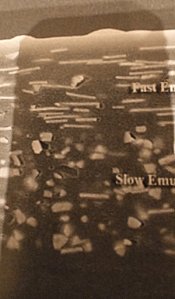Unfortunately Kodak literature (datasheets, books etc.) often uses sharpness as a synonym for resolution.
And using micro contrast in the original sense (they invented the term) as a descriptor of the rightmost part of the MTF curve.
That’s worth keeping in mind.
Apart from that, you are probably almost certainly right in that empirical observations of grain, clearly point to T-MAX 100 not being either a very homogeneously grained emulsion, neither a multilayer one.
400 and 100 T-MAX MTF and exposure curves gives us some hints that point in that direction too.
Just looking at the end product of scans and prints, 100 has a good long straight line and nice latitude. But it’s nothing compared to 400.
The real speed of (new) 400 is probably closer to 700 or 800.
Regarding the use of the one layer Kodachrome ideas used in later one layer films:
I’m afraid I have to delve into the same realm of unconfirmable “proclamations” that a certain other poster does.
But I have the information from two sources:
Wesley Hanson (inventor of the orange mask among other things) talks about one layer Kodachrome someplace in this video (I don’t have time to scrub through it to find the exact place right now, but if you haven’t watched it you really should take the time).
https://ethw.org/Wesley_T._Hanson
And an email conversation with a now deceased Kodak researcher, whom I mailed about if he knew of details about the one layer Kodachrome, among some other things.
Of course I can’t ask for permission to post the mails, and I won’t anyway, due to the information having a small but real likelihood of the still being under some kind of protection or NDA.






 horizontal motion blur is seen from the film advancing. Not many situations challenge a hassie
horizontal motion blur is seen from the film advancing. Not many situations challenge a hassie


